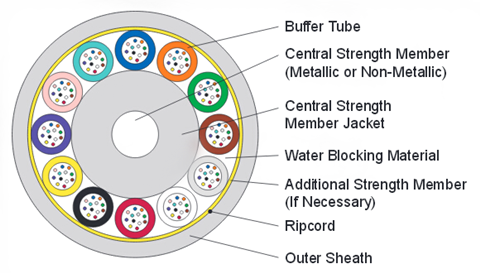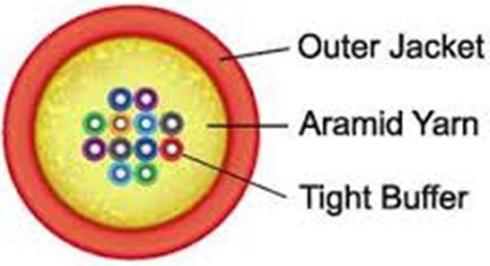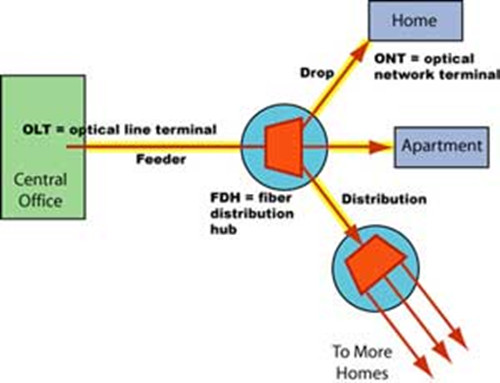FTTH (Fiber to the Home) network compared with technologies now used in most places, increases the connection speeds available for residences, apartment building and enterprises. FTTH network is the installation and use of optical fiber from a central point known as an access node to individual buildings. The links between subscriber and access node are achieved by fiber jumper cables. Loose-tube and tight buffer cables are commonly used to transmit signals with high speed, which are capable of supporting outdoor or indoor environment. Is there a cost-effective solution that can support both indoor and outdoor environment in FTTH network? To answer this, the construction and comparison of loose tube cable and tight buffer cable will be introduced in the following article.
Loose-Tube and Tight-Buffer Cable
The “buffer” in tight buffer cable refers to a basic component of fiber optic cable, which is the first layer used to define the type of cable construction. Typically a fiber optic cable consists of the optical fiber, buffer, strength members and an outer protective jacket (as showed in Figure 1). Loose-tube and tight-buffer cables are two basic cable design. Loose-tube cable is used in the majority of outside-plant installations, and tight-buffered cable, primarily used inside buildings.

Loose-tube cable consists of a buffer layer that has an inner diameter much larger than the diameter of the fiber see in the following picture. Thus, the cable will be subject to temperature extremes in the identification and administration of fibers in the system. That’s why loose-tube cables are usually used in outdoor application. The loose-tube cables designed for FTTH outdoor application are usually loose-tube gel-filled cables (LTGF cable). This type of cable is filled with a gel that displaces or blocks water and prevents it from penetrating or getting into the cable.
Tight buffer cable using a buffer attached to the fiber coating is generally smaller in diameter than loose buffer cable (showed in Figure 2). The minimum bend radius of a tight buffer cable is typically smaller than a comparable loose buffer cable. Thus tight buffer cable is usually used in indoor application.

Tight buffered indoor/outdoor cable with properly designed and manufactured can meet both indoor and outdoor application requirements. It combines the design requirements of traditional indoor cable and adds moisture protection and sunlight-resistant function to meet the standards for outdoor use. Tight buffered indoor/outdoor cable also meets one or more of the code requirements for flame-spread resistance and smoke generation.
Choose Tight Buffer Cable for FTTH Network
The inner construction of tight buffer indoor/outdoor cable have been introduced above. The following will explain why tight buffered indoor/outdoor cable is a better FTTH cabling solution. Figure 3 shows a clear structure of FTTH network.

Using the traditional choice of LTGF cables as the outdoor cable, there would be a conversion from one fiber type to another type, which includes prep work on the fiber, the need for splice tray, the routing of fibers in the tray, and other similar detail. Before termination and splicing, the gel of LTGF cable must be cleaned and the breakout point of the main cable must be blocked by some method to prevent oozing of the cable gel. In addition, this cable type must normally be terminated or spliced close to the cable entryway of a building to switch to indoor cable, as it generally incompatible with indoor fiber codes. This time consuming and labor intensive process adds hidden costs to install the LTGF cables.
However, using only tight buffer indoor/outdoor cable for FTTH is much more convenient and cost-effective. A tight-buffered indoor/outdoor cable can be used throughout the link, requiring no transitions at the building entryway. Tight buffer indoor/outdoor cable requires less care to avoid damaging fibers when stripping back the cable. The termination and splicing of these cables are easier than that of LTGF cables.
An important reason why choose tight-buffered indoor/outdoor cable for FTTH cable installation is the reliability of the overall system. Splicing are the weakest point in a FTTH network. With splicing, the bare fiber ends are open to dust, dirt, water, vapor, and handing which might reduce the fiber strength and increase brittleness. Choosing loose tube outdoor cable for FTTH, there will be splices after the conversion from one cable type to another type. The splices inside a building may be held in a cabinet that is open to the air, which might decrease the reliability of the FTTH network. Using the tight buffer indoor/outdoor cable could eliminate splicing and improve the installation reliability greatly.
Conclusion
This article has explained loose-tube and tight buffer indoor/outdoor cables. Network installer can run a single cable type and remove a transition point between the outside plant and the inside plant. At the same time, the reliability of the overall FTTH network can be increased greatly. FS.COM offers high quality fiber cable assemblies such as Patch Cords, Pigtails, MCPs, Breakout Cables etc. All of our custom fiber patch cords can be ordered as Single Mode 9/125, Multimode 62.5/125 OM1, Multimode 50/125 OM2 and Multimode 10 Gig 50/125 OM3/OM4 fibers. If you have any requirement, please send your request to us.

Thanks for sharing fiber optic solutions in dubai
ReplyDeleteThanks for sharing structured cabling companies in dubai
ReplyDelete